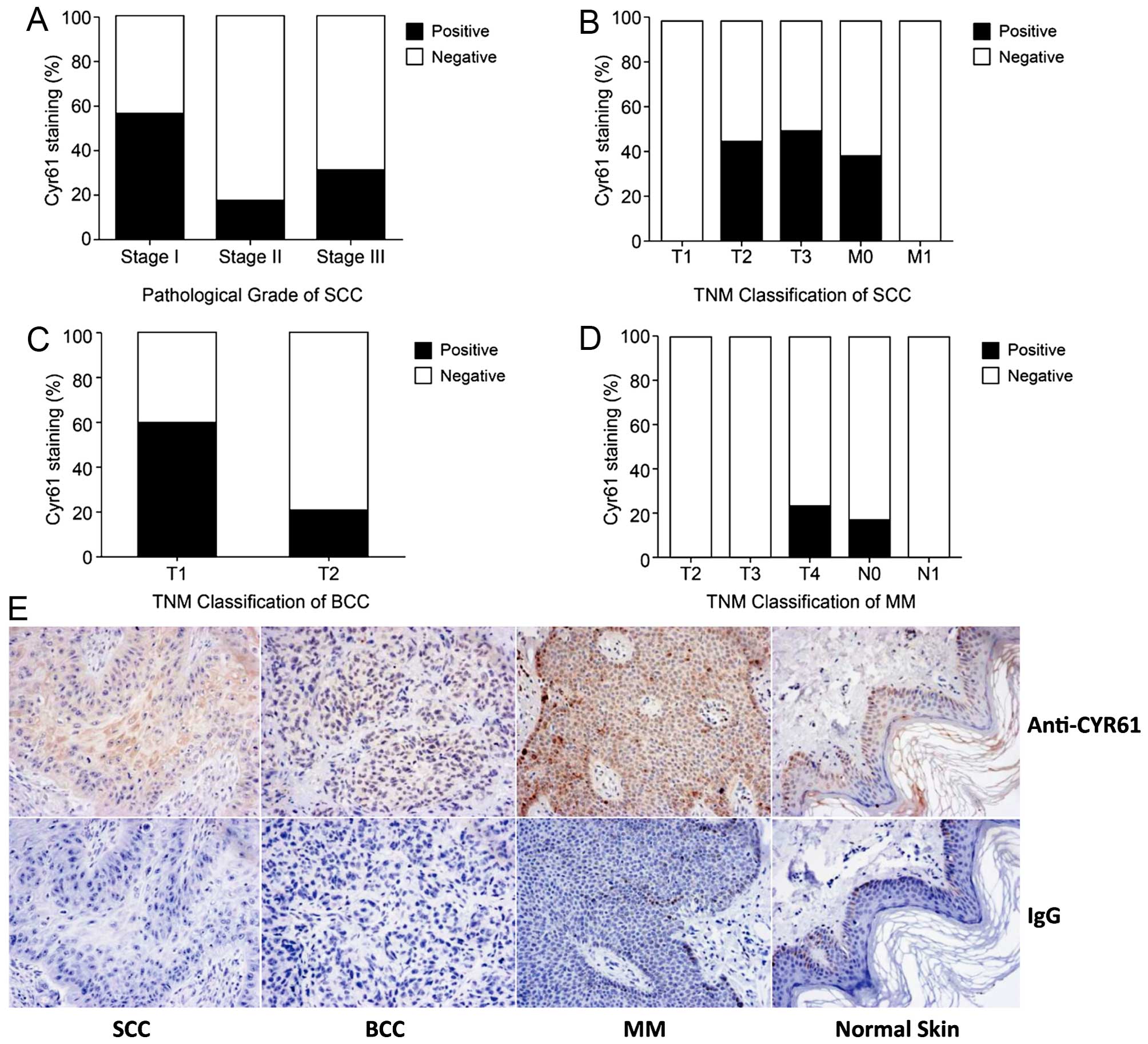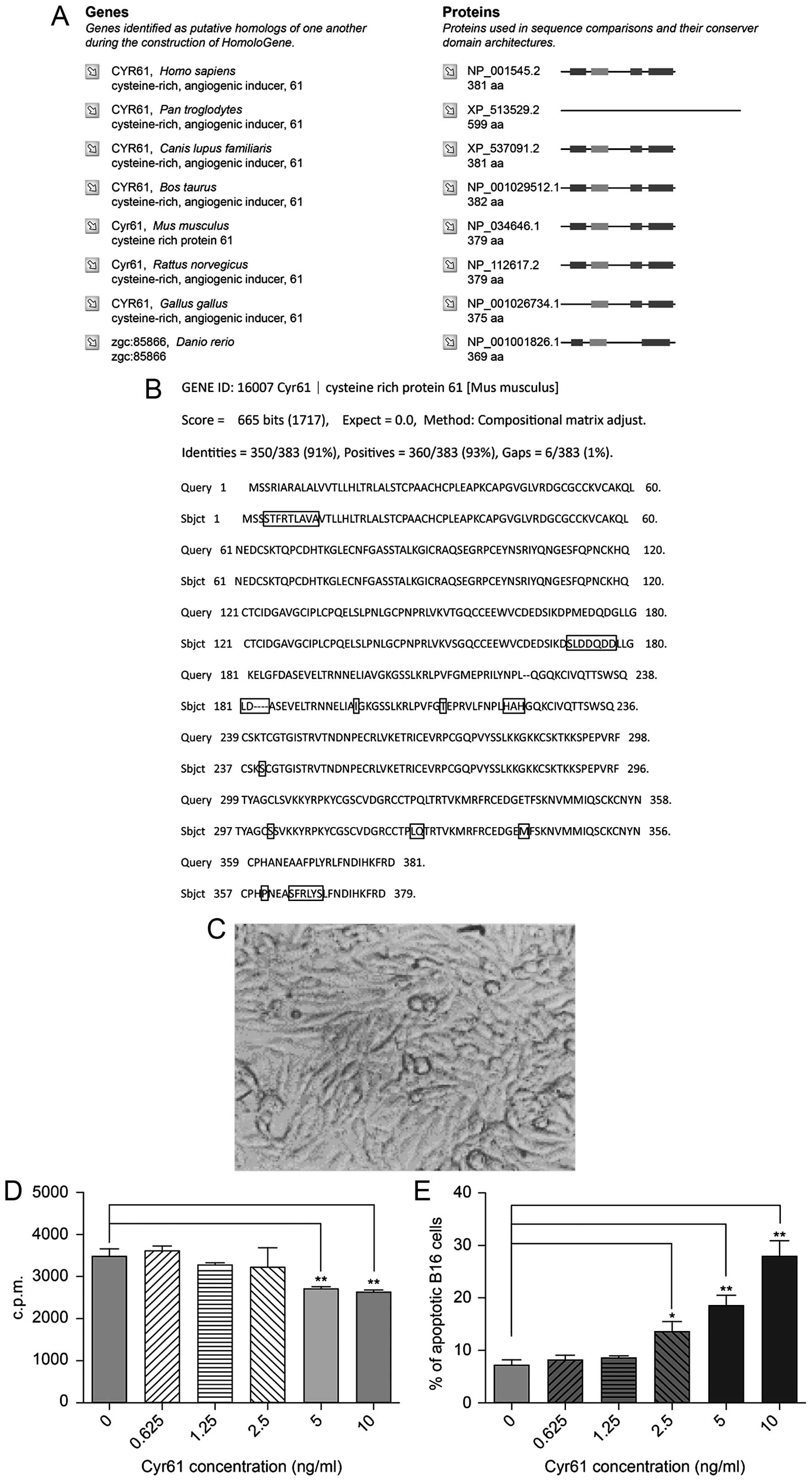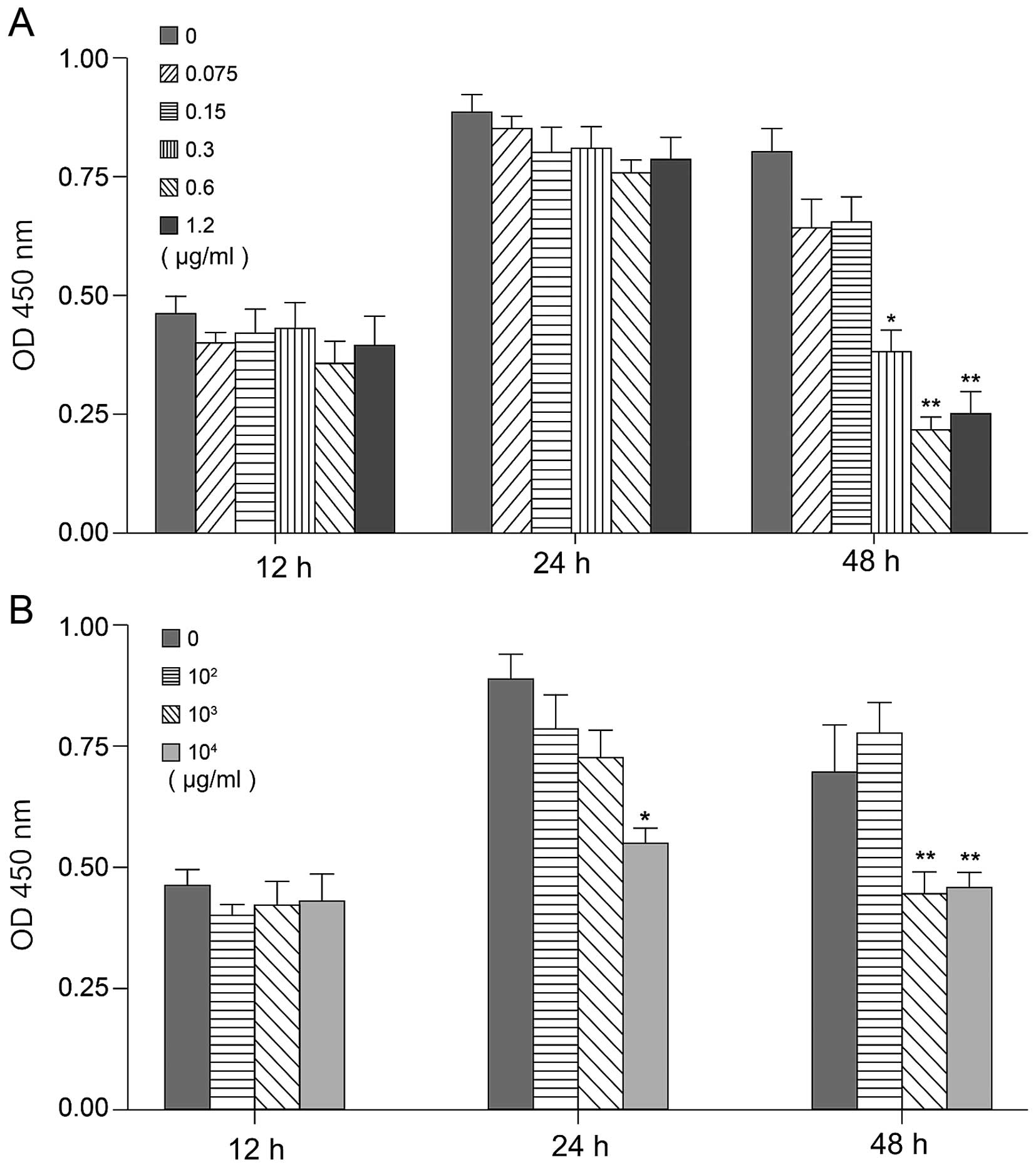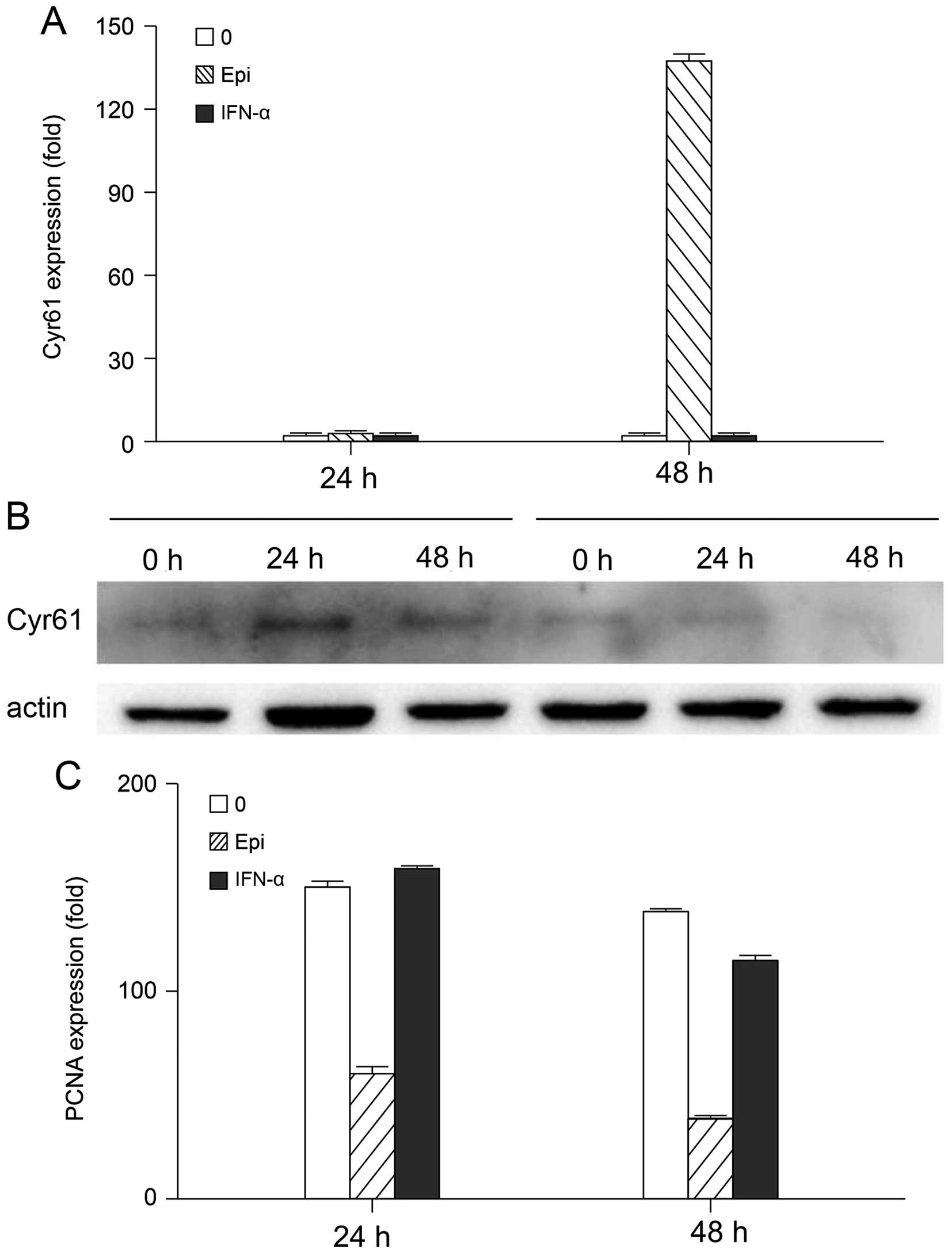CYR61 suppresses growth of human malignant melanoma
- Authors:
- Jun Chen
- Yang Liu
- Qilin Sun
- Beiqing Wang
- Ningli Li
- Xiangdong Chen
-
Affiliations: Department of Dermatology and Dermatologic Surgery, Shanghai Ninth People's Hospital Affiliated to Shanghai Jiaotong University School of Medicine, Shanghai 200011, P.R. China, Department of Immunology, Shanghai Jiaotong University School of Medicine, Shanghai 200011, P.R. China - Published online on: September 23, 2016 https://doi.org/10.3892/or.2016.5124
- Pages: 2697-2704
This article is mentioned in:
Abstract
 |
 |
 |
 |
|
Lau LF and Nathans D: Identification of a set of genes expressed during the G0/G1 transition of cultured mouse cells. EMBO J. 4:3145–3151. 1985.PubMed/NCBI | |
|
Brigstock DR, Goldschmeding R, Katsube KI, Lam SC, Lau LF, Lyons K, Naus C, Perbal B, Riser B, Takigawa M, et al: Proposal for a unified CCN nomenclature. Mol Pathol. 56:127–128. 2003. View Article : Google Scholar : PubMed/NCBI | |
|
Perbal B: CCN proteins: Multifunctional signalling regulators. Lancet. 363:62–64. 2004. View Article : Google Scholar : PubMed/NCBI | |
|
O'Brien TP, Yang GP, Sanders L and Lau LF: Expression of cyr61, a growth factor-inducible immediate-early gene. Mol Cell Biol. 10:3569–3577. 1990. View Article : Google Scholar : PubMed/NCBI | |
|
Brunner A, Chinn J, Neubauer M and Purchio AF: Identification of a gene family regulated by transforming growth factor-beta. DNA Cell Biol. 10:293–300. 1991. View Article : Google Scholar : PubMed/NCBI | |
|
Jay P, Bergé-Lefranc JL, Marsollier C, Méjean C, Taviaux S and Berta P: The human growth factor-inducible immediate early gene, CYR61, maps to chromosome 1p. Oncogene. 14:1753–1757. 1997. View Article : Google Scholar : PubMed/NCBI | |
|
Martinerie C, Viegas-Pequignot E, Nguyen VC and Perbal B: Chromosomal mapping and expression of the human cyr61 gene in tumour cells from the nervous system. Mol Pathol. 50:310–316. 1997. View Article : Google Scholar | |
|
Brigstock DR: The CCN family: A new stimulus package. J Endocrinol. 178:169–175. 2003. View Article : Google Scholar : PubMed/NCBI | |
|
Menéndez JA, Mehmi I, Griggs DW and Lupu R: The angiogenic factor CYR61 in breast cancer: Molecular pathology and therapeutic perspectives. Endocr Relat Cancer. 10:141–152. 2003. View Article : Google Scholar : PubMed/NCBI | |
|
Leask A and Abraham DJ: All in the CCN family: Essential matricellular signaling modulators emerge from the bunker. J Cell Sci. 119:4803–4810. 2006. View Article : Google Scholar : PubMed/NCBI | |
|
Tong X, O'Kelly J, Xie D, Mori A, Lemp N, McKenna R, Miller CW and Koeffler HP: Cyr61 suppresses the growth of non-small-cell lung cancer cells via the beta-catenin-c-myc-p53 pathway. Oncogene. 23:4847–4855. 2004. View Article : Google Scholar : PubMed/NCBI | |
|
Kim SY, Hahn HG, Nam KD, Park KC, Yun HY, Baek KJ, Kwon NS and Kim DS: A derivative of 2-aminothiazole inhibits melanogenesis in B16 mouse melanoma cells via glycogen synthase kinase 3β phosphorylation. J Pharm Pharmacol. 63:1031–1036. 2011. View Article : Google Scholar : PubMed/NCBI | |
|
Klebanoff CA, Gattinoni L, Palmer DC, Muranski P, Ji Y, Hinrichs CS, Borman ZA, Kerkar SP, Scott CD, Finkelstein SE, et al: Determinants of successful CD8+ T-cell adoptive immunotherapy for large established tumors in mice. Clin Cancer Res. 17:5343–5352. 2011. View Article : Google Scholar : PubMed/NCBI | |
|
Xiao H, Peng Y, Hong Y, Liu Y, Guo ZS, Bartlett DL, Fu N and He Y: Lentivector prime and vaccinia virus vector boost generate high-quality CD8 memory T cells and prevent autochthonous mouse melanoma. J Immunol. 187:1788–1796. 2011. View Article : Google Scholar : PubMed/NCBI | |
|
Babic AM, Kireeva ML, Kolesnikova TV and Lau LF: CYR61, a product of a growth factor-inducible immediate early gene, promotes angiogenesis and tumor growth. Proc Natl Acad Sci USA. 95:6355–6360. 1998. View Article : Google Scholar : PubMed/NCBI | |
|
Kunz M, Moeller S, Koczan D, Lorenz P, Wenger RH, Glocker MO, Thiesen HJ, Gross G and Ibrahim SM: Mechanisms of hypoxic gene regulation of angiogenesis factor Cyr61 in melanoma cells. J Biol Chem. 278:45651–45660. 2003. View Article : Google Scholar : PubMed/NCBI | |
|
Dobroff AS, Wang H, Melnikova VO, Villares GJ, Zigler M, Huang L and Bar-Eli M: Silencing cAMP-response element-binding protein (CREB) identifies CYR61 as a tumor suppressor gene in melanoma. J Biol Chem. 284:26194–26206. 2009. View Article : Google Scholar : PubMed/NCBI | |
|
Carmichael J, DeGraff WG, Gazdar AF, Minna JD and Mitchell JB: Evaluation of a tetrazolium-based semiautomated colorimetric assay: Assessment of radiosensitivity. Cancer Res. 47:943–946. 1987.PubMed/NCBI | |
|
Alley MC, Scudiero DA, Monks A, Hursey ML, Czerwinski MJ, Fine DL, Abbott BJ, Mayo JG, Shoemaker RH and Boyd MR: Feasibility of drug screening with panels of human tumor cell lines using a microculture tetrazolium assay. Cancer Res. 48:589–601. 1988.PubMed/NCBI | |
|
Zhang Q, Wu J, Cao Q, Xiao L, Wang L, He D, Ouyang G, Lin J, Shen B, Shi Y, et al: A critical role of Cyr61 in interleukin-17-dependent proliferation of fibroblast-like synoviocytes in rheumatoid arthritis. Arthritis Rheum. 60:3602–3612. 2009. View Article : Google Scholar : PubMed/NCBI | |
|
Sun M, Ma F, Zeng X, Liu Q, Zhao XL, Wu FX, Wu GP, Zhang ZF, Gu B, Zhao YF, et al: Triphalangeal thumb-polysyndactyly syndrome and syndactyly type IV are caused by genomic duplications involving the long range, limb-specific SHH enhancer. J Med Genet. 45:589–595. 2008. View Article : Google Scholar : PubMed/NCBI | |
|
Lin MT, Chang CC, Chen ST, Chang HL, Su JL, Chau YP and Kuo ML: Cyr61 expression confers resistance to apoptosis in breast cancer MCF-7 cells by a mechanism of NF-kappaB-dependent XIAP up-regulation. J Biol Chem. 279:24015–24023. 2004. View Article : Google Scholar : PubMed/NCBI | |
|
Menendez JA, Vellon L, Mehmi I, Teng PK, Griggs DW and Lupu R: A novel CYR61-triggered 'CYR61-alphavbeta3 integrin loop' regulates breast cancer cell survival and chemosensitivity through activation of ERK1/ERK2 MAPK signaling pathway. Oncogene. 24:761–779. 2005. View Article : Google Scholar | |
|
Xie D, Yin D, Wang HJ, Liu GT, Elashoff R, Black K and Koeffler HP: Levels of expression of CYR61 and CTGF are prognostic for tumor progression and survival of individuals with gliomas. Clin Cancer Res. 10:2072–2081. 2004. View Article : Google Scholar : PubMed/NCBI | |
|
Holloway SE, Beck AW, Girard L, Jaber MR, Barnett CC Jr, Brekken RA and Fleming JB: Increased expression of Cyr61 (CCN1) identified in peritoneal metastases from human pancreatic cancer. J Am Coll Surg. 200:371–377. 2005. View Article : Google Scholar : PubMed/NCBI | |
|
Tong X, Xie D, O'Kelly J, Miller CW, Muller-Tidow C and Koeffler HP: Cyr61, a member of CCN family, is a tumor suppressor in non-small cell lung cancer. J Biol Chem. 276:47709–47714. 2001. View Article : Google Scholar : PubMed/NCBI | |
|
Sampath D, Zhu Y, Winneker RC and Zhang Z: Aberrant expression of Cyr61, a member of the CCN (CTGF/Cyr61/Cef10/NOVH) family, and dysregulation by 17 beta-estradiol and basic fibroblast growth factor in human uterine leiomyomas. J Clin Endocrinol Metab. 86:1707–1715. 2001.PubMed/NCBI | |
|
Wasenius VM, Hemmer S, Kettunen E, Knuutila S, Franssila K and Joensuu H: Hepatocyte growth factor receptor, matrix metalloproteinase-11, tissue inhibitor of metalloproteinase-1, and fibronectin are up-regulated in papillary thyroid carcinoma: A cDNA and tissue microarray study. Clin Cancer Res. 9:68–75. 2003.PubMed/NCBI | |
|
Chien W, Kumagai T, Miller CW, Desmond JC, Frank JM, Said JW and Koeffler HP: Cyr61 suppresses growth of human endometrial cancer cells. J Biol Chem. 279:53087–53096. 2004. View Article : Google Scholar : PubMed/NCBI | |
|
Dika E, Fanti PA, Vaccari S, Patrizi A and Maibach HI: Causal relationship between exposure to chemicals and malignant melanoma? A review and study proposal. Rev Environ Health. 25:255–259. 2010. View Article : Google Scholar : PubMed/NCBI | |
|
Kong Y, Kumar SM and Xu X: Molecular pathogenesis of sporadic melanoma and melanoma-initiating cells. Arch Pathol Lab Med. 134:1740–1749. 2010.PubMed/NCBI | |
|
Mihić LL, Bulat V, Situm M, Krolo I and Seserko A: The role of apoptosis in the pathogenesis of malignant melanoma. Coll Antropol. 34(Suppl 2): 303–306. 2010. | |
|
Khalid U, Saleem T, Imam AM and Khan MR: Pathogenesis, diagnosis and management of primary melanoma of the colon. World J Surg Oncol. 9:142011. View Article : Google Scholar : PubMed/NCBI | |
|
Gruber F, Kastelan M, Brajac I, Saftić M, Peharda V, Cabrijan L, Stanić Zgombić Z and Simonić E: Molecular and genetic mechanisms in melanoma. Coll Antropol. 32(Suppl 2): 147–152. 2008. | |
|
Ibrahim N and Haluska FG: Molecular pathogenesis of cutaneous melanocytic neoplasms. Annu Rev Pathol. 4:551–579. 2009. View Article : Google Scholar : PubMed/NCBI | |
|
Russo AE, Torrisi E, Bevelacqua Y, Perrotta R, Libra M, McCubrey JA, Spandidos DA, Stivala F and Malaponte G: Melanoma: Molecular pathogenesis and emerging target therapies (Review). Int J Oncol. 34:1481–1489. 2009.PubMed/NCBI | |
|
Ugurel S, Utikal J and Becker JC: Tumor biomarkers in melanoma. Cancer Control. 16:219–224. 2009.PubMed/NCBI | |
|
Chandeck C and Mooi WJ: Oncogene-induced cellular senescence. Adv Anat Pathol. 17:42–48. 2010. | |
|
Parsons BL, Myers MB, Meng F, Wang Y and McKinzie PB: Oncomutations as biomarkers of cancer risk. Environ Mol Mutagen. 51:836–850. 2010. View Article : Google Scholar : PubMed/NCBI | |
|
Adhikari AS and Iwakuma T: Mutant p53 gain of oncogenic function: In vivo evidence, mechanism of action and its clinical implications. Fukuoka Igaku Zasshi. 100:217–228. 2009.PubMed/NCBI | |
|
Bar J, Moskovits N and Oren M: Involvement of stromal p53 in tumor-stroma interactions. Semin Cell Dev Biol. 21:47–54. 2010. View Article : Google Scholar : | |
|
Lane D and Levine A: p53 Research: The past thirty years and the next thirty years. Cold Spring Harb Perspect Biol. 2:a0008932010. View Article : Google Scholar : PubMed/NCBI | |
|
Solomon H, Brosh R, Buganim Y and Rotter V: Inactivation of the p53 tumor suppressor gene and activation of the Ras oncogene: Cooperative events in tumorigenesis. Discov Med. 9:448–454. 2010.PubMed/NCBI | |
|
Dervan PA, Magee HM, Buckley C and Carney DN: Proliferating cell nuclear antigen counts in formalin-fixed paraffin-embedded tissue correlate with Ki-67 in fresh tissue. Am J Clin Pathol. 97(Suppl 1): S21–S28. 1992.PubMed/NCBI | |
|
Bolton WE, Mikulka WR, Healy CG, Schmittling RJ and Kenyon NS: Expression of proliferation associated antigens in the cell cycle of synchronized mammalian cells. Cytometry. 13:117–126. 1992. View Article : Google Scholar : PubMed/NCBI | |
|
Nakano H, Namatame K, Suzuki T, Takahashi H, Sakai H, Nakamura T and Kumada K: Histopathological response to preoperative chemotherapy including 5-fluorouracil additionally assessed by immunocytochemical and pharmacologic parameters in patients with advanced gastric cancer. Surg Today. 26:482–488. 1996. View Article : Google Scholar : PubMed/NCBI | |
|
Hiraga Y, Tanaka S, Haruma K, Yoshihara M, Sumii K, Kajiyama G, Shimamoto F and Kohno N: Immunoreactive MUC1 expression at the deepest invasive portion correlates with prognosis of colorectal cancer. Oncology. 55:307–319. 1998. View Article : Google Scholar : PubMed/NCBI | |
|
Kunihiro M, Tanaka S, Haruma K, Yoshihara M, Sumii K, Kajiyama G and Shimamoto F: Combined expression of HLA-DR antigen and proliferating cell nuclear antigen correlate with colorectal cancer prognosis. Oncology. 55:326–333. 1998. View Article : Google Scholar : PubMed/NCBI | |
|
Jia X and Han C: Biomarkers in the studies on chemoprevention of colorectal cancer. Wei Sheng Yan Jiu. 29:109–111. 2000.In Chinese. | |
|
Reszeć J, Kańczuga-Koda L, Sulkowska M, Koda M, Cylwik J, Barwijuk-Machała M and Sulkowski S: An evaluation of Ki-67 and PCNA expression in conjunctival and eyelid tumours. Folia Morphol (Warsz). 63:95–98. 2004. | |
|
Meyer O: Interferons and autoimmune disorders. Joint Bone Spine. 76:464–473. 2009. View Article : Google Scholar : PubMed/NCBI | |
|
Heng DY and Bukowski RM: Anti-angiogenic targets in the treatment of advanced renal cell carcinoma. Curr Cancer Drug Targets. 8:676–682. 2008. View Article : Google Scholar : PubMed/NCBI | |
|
Agarwala SS and Case S: Everolimus (RAD001) in the treatment of advanced renal cell carcinoma: A review. Oncologist. 15:236–245. 2010. View Article : Google Scholar : PubMed/NCBI | |
|
Ather MH, Masood N and Siddiqui T: Current management of advanced and metastatic renal cell carcinoma. Urol J. 7:1–9. 2010.PubMed/NCBI | |
|
Ramakrishna R and Manoharan A: Sustained long-term remissions with weekly interferon maintenance therapy in hairy cell leukemia. Asia Pac J Clin Oncol. 6:210–212. 2010. View Article : Google Scholar : PubMed/NCBI | |
|
Baldo P, Rupolo M, Compagnoni A, Lazzarini R, Bearz A, Cannizzaro R, Spazzapan S, Truccolo I and Moja L: Interferon-alpha for maintenance of follicular lymphoma. Cochrane Database Syst Rev. CD0046292010.PubMed/NCBI | |
|
Burchert A and Neubauer A: Interferon alpha and T-cell responses in chronic myeloid leukemia. Leuk Lymphoma. 46:167–175. 2005. View Article : Google Scholar | |
|
Khoo TL, Vangsted AJ, Joshua D and Gibson J: Interferon-alpha in the treatment of multiple myeloma. Curr Drug Targets. 12:437–446. 2011. View Article : Google Scholar | |
|
Garbe C, Eigentler TK, Keilholz U, Hauschild A and Kirkwood JM: Systematic review of medical treatment in melanoma: Current status and future prospects. Oncologist. 16:5–24. 2011. View Article : Google Scholar : PubMed/NCBI | |
|
Aversa SM, Cattelan AM, Salvagno L, Crivellari G, Banna G, Trevenzoli M, Chiarion-Sileni V and Monfardini S: Treatments of AIDS-related Kaposi's sarcoma. Crit Rev Oncol Hematol. 53:253–265. 2005. View Article : Google Scholar : PubMed/NCBI | |
|
Chowdhury S, Larkin JM and Gore ME: Recent advances in the treatment of renal cell carcinoma and the role of targeted therapies. Eur J Cancer. 44:2152–2161. 2008. View Article : Google Scholar : PubMed/NCBI | |
|
Massironi S, Sciola V, Peracchi M, Ciafardini C, Spampatti MP and Conte D: Neuroendocrine tumors of the gastro-entero-pancreatic system. World J Gastroenterol. 14:5377–5384. 2008. View Article : Google Scholar : PubMed/NCBI |









